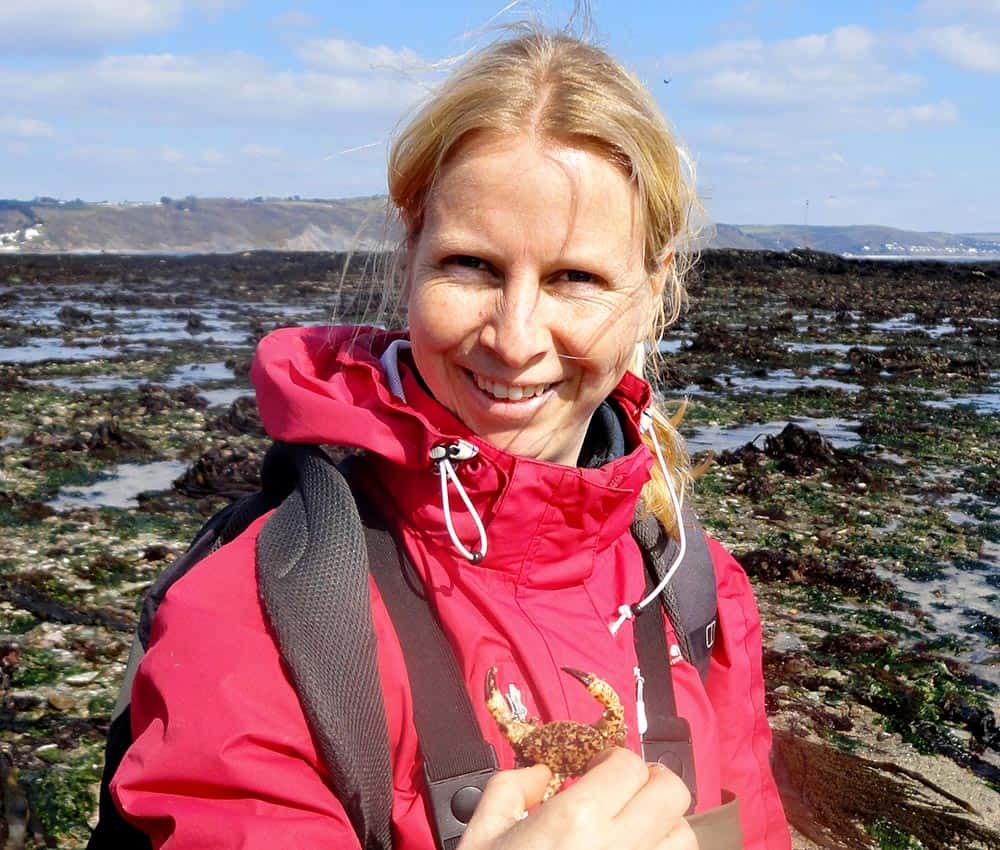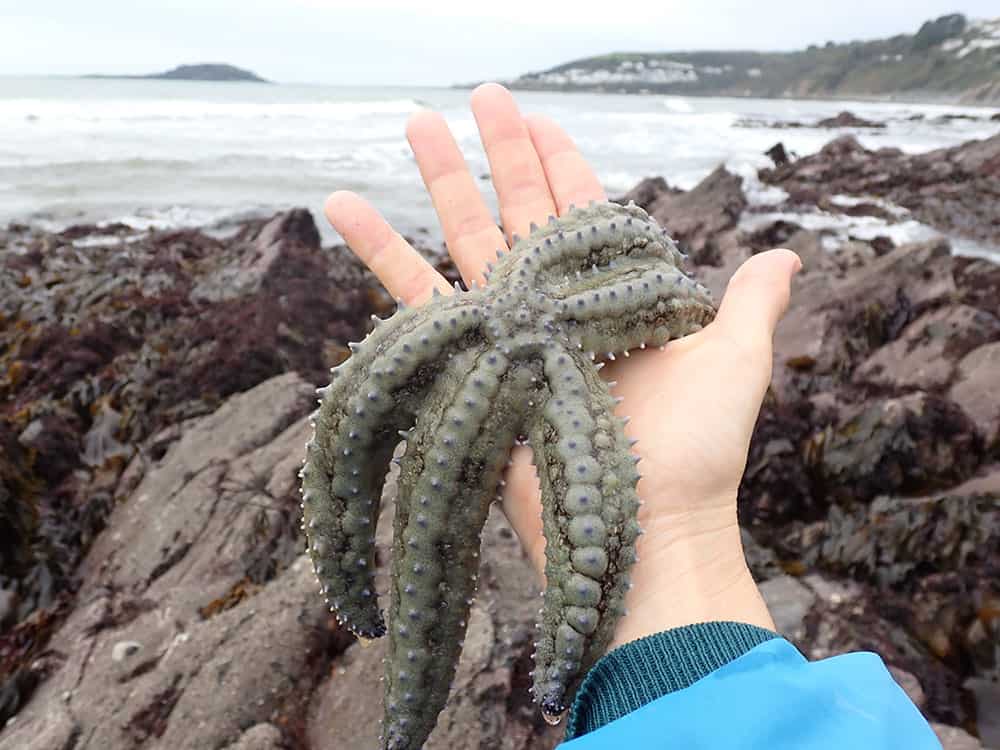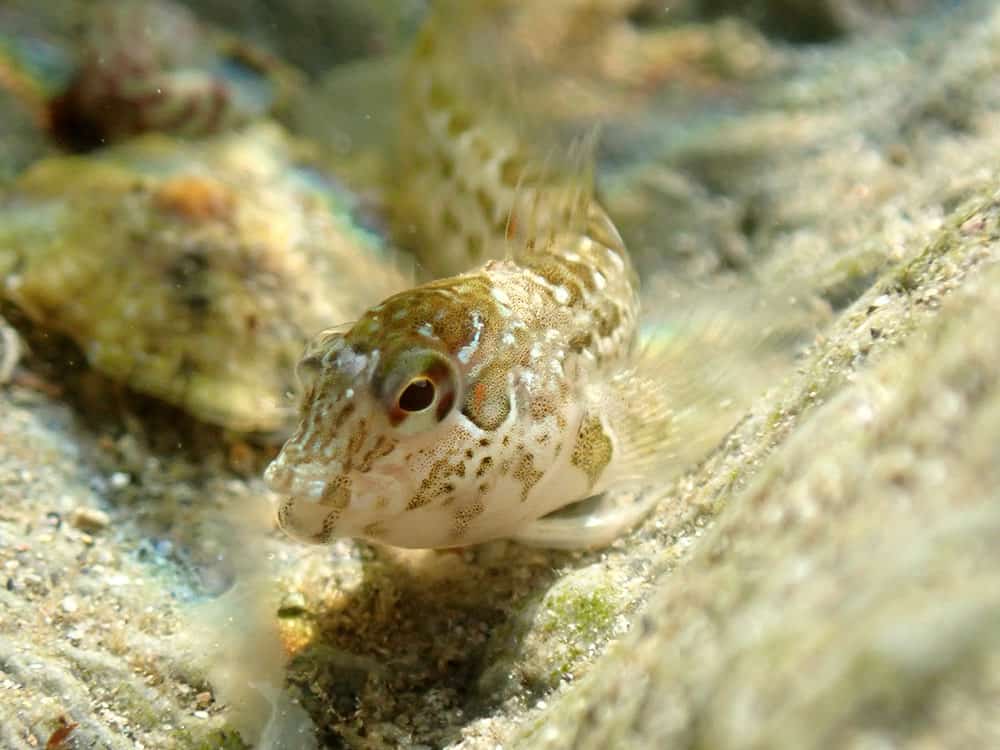Exploring Rock Pools with Cornish Conservationist Heather Buttivant
All along the beautiful and rugged west country coast are sunken, rocky worlds teeming with life.
Rock pools continue to captivate all those who explore their many crags and crevices, an exhilarating holiday activity the whole family can enjoy.
We were excited to catch up with Cornish conservationist, marine wildlife expert and author, Heather Buttivant, to find out more about these fascinating habitats. Heather has recently published her new book, Rock Pool: Extraordinary Encounters Between the Tides, and was keen to share some of her incredible knowledge and riveting accounts. Who better to ask the questions than our very own roving amphibian reporter, Mr Toad.

Photo credit: Heather Buttivant
Q&A with Cornish Conservationist & Wildlife Expert, Heather Buttivant
Mr Toad: Thrilled to meet you, Heather. May I begin by asking if you’ve always had a passion for marine wildlife?
Heather: It’s lovely to meet you too, Mr Toad. Growing up on the north coast of Cornwall, I had the most fantastic playground any child could wish for. Whether I was exploring the caves or splashing in the pools, I loved nothing better than discovering wildlife in hidden places. My ever-growing shell collection was a bone of contention with my parents, but finding out the names of my treasures was probably my first step towards studying the amazing lives of our marine creatures.
Mr Toad: Could you tell us a bit more about the projects you are involved in?
Heather: When I’m not writing, I’m usually on a beach doing a survey or showing people the rock pools. I volunteer with Cornwall Wildlife Trust and local marine conservation groups, taking children and their families or school groups out on rock pool safaris to learn about the animals and how to look after them. Organised events are a wonderful way to see more than you would on your own and we’re all looking forward to being able to re-start group events when it’s safe to do so. I also take part in Shoresearch surveys and other citizen science projects, recording the marine life on our shores. There are lots of opportunities to get involved in local projects all around the UK and we can all do our bit for conservation by doing a beach clean every time we visit a beach.
Mr Toad: What makes rock pooling such a fun and fascinating activity?
Heather: You never know what you will find in a rock pool. I’m in my forties now and still find something new nearly every time I go to the beach. The colours of the rock pools and the ways in which their inhabitants have adapted to life between the tides also makes them endlessly fascinating.
Mr Toad: What kinds of sea creatures can we expect to find in a Cornish rock pool?
Heather: There are few better places than a rock pool if you want to come face-to-face with some incredible wildlife. Even our most humble creatures like limpets and barnacles have extraordinary survival skills, and the bright anemones, scuttling crabs and cheeky prawns are always entertaining to watch. If you are lucky, and the tides are right, you can find almost anything from corals to flatfish, from swimming crabs to octopus.
Mr Toad: How can we stay safe while rock pooling?
Heather: Beaches are wonderful and rock pooling is generally safe if you’re careful, but never underestimate the power of the sea. Always check the tide times before you go rock pooling and aim to start an hour or two before the low tide. Dress for the weather, stay away from cliffs and large waves, and move away from the low water mark before the tide turns – remember that the tide may sweep in behind you. If you see anyone in serious trouble or need urgent help yourself, call the Coastguard on 999.
Mr Toad: What essential equipment do all good rock poolers need?
Heather: My top tip is to leave your net at home. Delicate rock pool animals are easily hurt by nets poking around and crabs can become tangled in them. It’s far easier to gently scoop an animal into a small tub or bucket of seawater. Wellies or good beach shoes are essential as the rocks can be sharp and slippery. Your eyes are your best piece of equipment and if you go slowly and look closely, you’ll be able to see the animals moving about the pools. A magnifying glass or hand lens can also be useful.

Credit: Heather Buttivant
Mr Toad: Where in a rock pool should we be looking?
Heather: Sea creatures need to stay in or near the water to survive, so on hot, sunny summer days, they will be doing their best to hide away safely under rocks and seaweed or in shady overhangs. The pools are the animals’ homes so it’s important not to disturb them. If you turn a stone or lift seaweed, do it gently and be sure to put it back exactly as you found it.
Mr Toad: Is it okay to handle or catch the creatures we find hiding in rock pools?
Heather: Most rock pool animals can be safely handled, although watching them moving naturally about the pools is best of all. It’s important to only put one animal at a time into a tub or bucket of seawater so that they don’t overheat, run out of oxygen or attack each other. If an animal is stuck to the rock or is soft and squidgy, it’s best left where it is.
Mr Toad: What’s been your most exciting rock pool encounter?
Heather: Finding scarlet and gold cup corals on my childhood beach took my breath away, as did meeting a fully-grown catshark on a beach near my new home in south-east Cornwall. But it is always my most recent encounter that is the most fresh and exciting. Last week my son spotted crystal jellyfish while we were paddling and we discovered sea grass growing in the bottom of our swimming rock-pool.
Mr Toad: What’s your favourite rock pool dweller and why?
Heather: I am a huge fan of sea slugs! They’re far more colourful than garden slugs and come in some crazy-looking designs that allow them to hide on the things they eat. The great grey sea slug looks like a fluffy white sheep until it eats an anemone and turns a pinky-red. This slug even retains the stinging cells of the anemone to defend itself against predators. Other slugs are bright purple, yellow or orange and some can squirt acid or release a cloud of purple ink if they are attacked.
Mr Toad: What’s the weirdest creature you’ve ever seen, and what’s the most wonderful?
Heather: There’s no shortage of weirdness in the rock pools so I had no problem filling my book with incredible stories. There are fish that can breathe through their skins out of water, starfish and crabs that can re-grow limbs and (my son’s favourite) a slug with no bottom. Probably the strangest and most wonderful animal I have seen is the curled octopus. Watching it change the colour and texture of its skin to match its mood and background was mesmerising.
Mr Toad: If you had to live the life of a rock pool resident, what would you be, and why?
Heather: Blennies are common rock pool fish and they seem to love life, so that would be my top choice. They love to spend their days propped up on a sunny rock, watching the world go by and they have wide, toothy grins. Being able to change colour would be fun and keep me safe, but I’m not sure I could get used to nibbling the legs off barnacles for food. I’d rather stick to sandy sandwiches.

Credit: Heather Buttivant
Mr Toad: Where are your favourite rock pooling beaches?
Heather: Every beach is different, so I love exploring new places. Devon and Cornwall have endless great rocky beaches and Kimmeridge in Dorset is lovely, although I spend most of my time close to home in Looe as I never grow tired of my local pools. I’m a big fan of the rocky coasts of Wales, Scotland and Yorkshire too and I’m sure there are many more I have yet to discover around the UK and Ireland.
Mr Toad: Are there any rock pool creatures that we need to be careful around?
Heather: Fortunately, there’s not much that is likely to seriously hurt you in our rock pools, but it is still important to be careful around wild animals. Avoid touching anything with tentacles like anemones and jellyfish as they can sting. Crabs have strong pincers so you should be careful around them. I have a page on my Cornish Rock Pools website explaining how to pick up a crab safely (for you and the crab). Most importantly, always avoid touching your eyes and mouth while rock pooling and wash your hands well afterwards.
Mr Toad: How do we go about identifying the marine wildlife we find?
Heather: There are lots of great apps, websites and groups to help you identify your finds and find out more. I have some simple, free guides to common species on my website and I love to hear what people have been finding on the shore. Your local Wildlife Trust or volunteer marine group will be happy to hear from you too.
Mr Toad: What needs to be done to ensure that our rock pools can remain thriving habitats for sea life?
Heather: We can all do our bit by not disturbing wildlife and leaving no litter behind when we visit the beach. Why not do a litter pick before you leave the beach and know that you have left it better than when you found it? Plastics and rising atmospheric carbon dioxide levels are causing all sorts of problems for sea life, so we can make a real difference by avoiding plastic packaging and consuming less fuel and electricity in our everyday lives.
Mr Toad: Where can our budding rock pool explorers go for more resources and information?
Heather: There are lots of fantastic wildlife and marine conservation organisations that have guides and resources for you to explore. Check out the Marine Conservation Society, The Shark Trust, the Marine Biological Association, The Rock Pool Project, The Wildlife Trusts and, of course, my Cornish Rock Pools website and my book. Happy rock pooling!
A big thank you to Heather for her compelling insight into rock pooling and the amazing creatures that inhabit these watery worlds.
